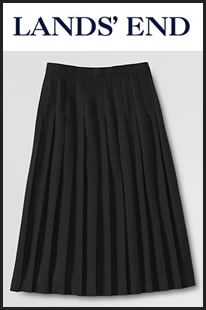Reality Check: Thin is Not Always In

(Photo credit: The pleated skirt, a style that flatters only the flattest of waistlines, from Lands' End) The fashion distress of my high school years was the knife-pleat skirt such as the Lands' End style pictured. Despite being thin as a teenager, my stomach was never flat or even indented, as seemed to be the case with the glamorous girls among my student peers who chose partially stitched-down pleat styles to fulfill the skirt requirement of our educational dress code. Though pleated skirts remain popular today for school uniforms, during the late 1980s and early 1990s when some of my friends wore them, pleated skirts were also a part of mainstream fashion and were a trendy choice if you wanted to impress people with your sense of style. Frustration over my inability to look good in pleated skirts remained until after high school, when thankfully, I exited the uniform environment and pleated skirts moved out of mainstream fashion as well.
The pleated skirt has enjoyed renewed popularity over the last few years, especially as celebrities have been photographed wearing short chiffon versions. The fact remains, however, that skirts pleated all around are unflattering to most women because they exaggerate even the slightest roundness of the tummy when worn. Skirts with partial stitching to hold down pleats for several inches from the waistline toward the hipline (such as the style pictured) have always appeared to me to emphasize roundness even more than pleats left completely loose, yet waist yoke stitching remains a popular treatment for pleated skirts, especially for school uniforms.
In retrospect, I realize that most of the seemingly elite group within my peers who had abdomens flat enough to look good in pleated skirts had not matured enough to attain a womanly figure. Their narrow waist-to-hip ratios fell into the junior size classification for straighter figures. A woman's figure changes from the teens throughout each decade of her life and is influenced by many factors, including childbearing and ethnicity. Some women are genetically destined to mature into a curvier shape early in their teens, while others may have a more straight figure all of their lives. The most common of variants for the abdominal shape of younger women is monthly abdominal bloating that fluctuates along with hormones. For those of us who aim to dress with both style and modesty, a fitted waistline is an important option because this is the one area that can add dimension to an outfit without being overly revealing. Many styles more forgiving than the pleated skirt can accomplish this, though, especially skirts or dresses that gently skim the waist with a flat layer of fabric and then flare at the hem.
And when wearing those styles that define the waist, accepting reality about the natural shape that God designed for women to have should bring confidence and new perspective to allowing a certain amount of tummy curve to show. California plastic surgeon Dr. Steven Teitelbaum offered insight during the May 2011 Women's Wear Daily Beauty Forum which should be an encouragement to women who may hesitate to reveal a curved abdomen by wearing outfits with shaped waistlines. Fashionista.com reporter Cheryl Wischhover summarized his comments, "If you get a tummy tuck, don’t ask for a perfectly flat abdomen-–it will masculinize you. Dr. Teitelbaum said a bit of convexity in a woman’s abdomen is most attractive."
This is refreshing news to those of us bombarded by images from the fashion world featuring underweight teenage models who hold in their stomachs for photos which are then retouched before printing. If femininity is the goal, then reality will get you there. Reality is that most women do not have abdomens that are flat in all postures throughout the day, even if they are a perfect weight for their height. I worked as a patternmaker for a designer runway show in New York in 2008. Our top model was a newcomer to the industry, and despite being beautiful and slender at age seventeen, her tummy had a small pooch that showed through some of the tight, shiny fabrics she wore for the show. The more experienced models repeatedly reminded her before her runway walks to hold in her stomach. What an example of reality, even for a slim girl who was chosen by a major designer to be his lead model.
Once beyond the teen years, abdominal convexity should be even more expected as a natural feature of the adult female figure. This is not to allay responsibility for proper weight management and exercise that may improve posture. Portrait artists have noted that women naturally stand with the abdomen tilted slightly forward, while ballet masters train their students to pull that tilt inward so that the abdomen is more perpendicular to the ground when standing. Pilates exercises focus on strengthening the core abdominal muscles as an essential part of posture. Maintaining proper digestion through fiber, digestive enzyme, and other colon support supplements may reduce bloating. Consultation with a health professional may yield a surprising reduction in waistline size once proper digestive health is attained. Then, when all else has been addressed, remember advice from Dr. Teitelbaum that "a bit of convexity . . . is most attractive."